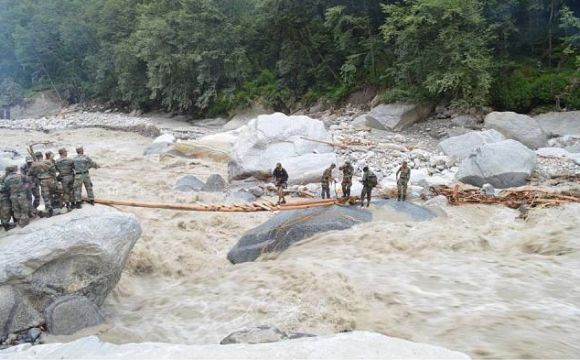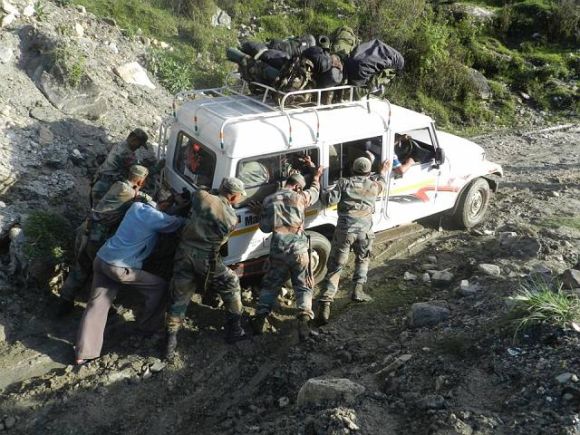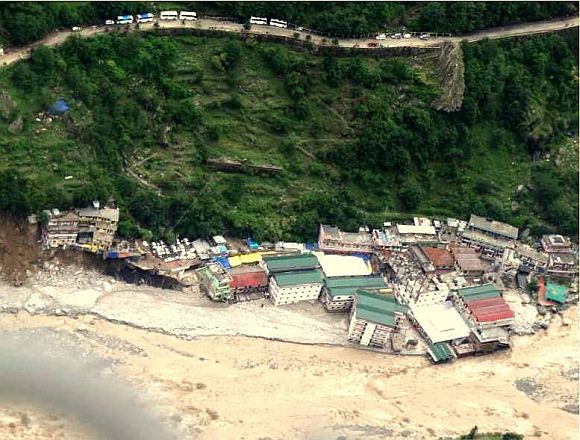
The ministry of tourism is less concerned about the impact of the floods on life and property, but is more focused on promoting tourism, says Swathi Seshadri. Anupam Chakravartty reports
The Char Dham Yatra, a trail that leads to four holy shrines of Hindu pilgrimage in the Himalayan state of Uttarakhand, opened to pilgrims on May 13 this year. In a month, almost 1.3 million pilgrims completed the journey to the four shrines of Gangotri, Yamunotri, Kedarnath and Badrinath -- all located at altitudes above 3,000 metre from mean sea level. While such intensive tourism brings in huge revenue, the pressures of hosting such vast numbers of pilgrims are telling on the state, which finds itself ill-equipped.
Booming business, big losses
Tourism in the state has increased by 168 per cent (213 per cent according to the Uttarakhand tourism department) over the past 12 years. According to Saurabh Sanyal, executive director of PHD Chamber of Commerce and Industry, a Delhi based body of industries, tourism contributes about 27 per cent or Rs 26,500 crore to Uttarakhand’s gross state domestic product.
The consequences of unchecked tourism in the state were only too evident in recent days when tragedy struck. On June 16 cloudbursts and extreme rains caused massive flooding and devastation in the state. The temple town of Kedarnath, which according to Char Dham Yatra tour operators was hosting an estimated 34,000 pilgrims at the time, was destroyed when a torrent of mud, mountain debris and water hit the town. The yatra was interrupted in peak season with five more months to go before temple authorities closed the four shrines in November before the harsh winter months.
Kind courtesy https://www.downtoearth.org.in/
…

PHD Chamber of Commerce and Industry estimates Uttarakhand has incurred a loss of about Rs 12,000 crore, based on gross state domestic product figures from the state budget for 2013-14. “GSDP of Uttarakhand at factor cost at current prices stands at about Rs 1,07,548 crore in the year that came to an end on March 31, 2013.
Eleven per cent of the GSDP has been washed away in terms of prospective tourism earnings due to floods that engulfed the state in the middle of this month,” says Sanyal in a statement issued on June 27.
Swathi Seshadri of Bangalore-based non-profit Equations, which works for equitable tourism, says tourism is unsustainable in Uttarakhand as ever-increasing pilgrimage puts immense pressure on resources. “While the state's town and country planning department is responsible for making master plans for key regions in the state, it is Uttarakhand's tourism department that has made the tourism development master plan for 2007 to 2022,” points out Seshadri.
“The Union ministry of tourism has yet another plan for the Valley of Flowers, which suggested a carrying capacity for the region but did not formulate any regulations. However, there is no coordination between these government agencies when preparing these plans. There is confusion about who is planning for these regions. They seem to be open for all,” she adds.
The only tourism regulations or plans in use in the country are for the tourists to the Amarnath Yatra or to ManasarovarLake in Tibet. The Amarnath Shrine Board issues warning notices as per the Amarnath Shrine Act, which includes marking points which are prone to landslides or avalanches. There are no such measures for pilgrimage trails like the Char Dham Yatra. The Uttarakhand Tourism Policy 2001 aims at establishing world class infrastructure, attracting more and more private players, and finding new tourism destinations. But so far, no assessment or impact of tourism or carrying capacity has been done, says Seshadri.
…

Almost 80 per cent of tourists to Uttarakhand arrive with the aim of completing the Char Dham Yatra. The heavy traffic on the routes to the shrines during tourist season from May to November cause a high number of road accidents, which a state police official from Dehradun blames on the greed of tour operators.
“The surge in the number of pilgrims visiting the temples in one month is mostly because of these tour operators. The tour operators are in a rush to make a quick buck and make five to six trips a month to the four temples. The drivers do not get rest and often end up in accidents,” says the police official.
On the other hand, tour operators such as ‘Sacred Yatra’, a Rishikesh based travel operator, say that pilgrims want to spend less time at these altitudes because of the difficult terrain.
In 2008 Uttarakhand Police made it mandatory for pilgrims to complete the trail within 10 days. However, none of the tour operators followed the police diktat in practice, as pilgrims were charged a hefty sum of money for a whirlwind tour of the four pilgrimage sites. Excluding hotel costs, a Char Dham Yatra, that could take five to seven days to complete, costs about Rs 9,000 for a vehicle that carries five or six people from Rishikesh.
...

In spite of the mushrooming of hotels along river banks, triggered by the tourist boom, a shortage of accommodation persists. A working paper of the Indian Council for Research on International Economic Relations published in 2008 on the economy of the state in 2006 illustrates this shortage. A survey conducted by the authors of the paper on development strategy for the hill districts of Uttarakhand stated that annually the state has only 8.4 tourist rent houses per million tourists, 102.5 hotels and guest houses per million tourists, and 337 beds available for every million tourists.
The shortage of dwelling units to meet the ever-increasing numbers of tourists visiting the state led to the mushrooming of illegal structures, some of which were constructed right on the riverbanks. According to estimates from the Uttarakhand Hotel and Restaurant Association, the recent floods washed away over 100 small hotels which had been constructed right on the riverbanks.
The Union ministry of tourism, however, seems slow to realise the need for better regulation and infrastructure in tourist areas. The first press release the ministry issued after the Uttarakhand floods was on June 19 to announce a new campaign -- 777 days of the Indian Himalayas -- to promote the Himalayas as a tourism destination to the world.
It was only much later, on June 24, that the ministry issued a statement saying that it would pledge Rs 1 crore to the flood victims of Uttarakhand. On June 26, the ministry sanctioned a special financial package of Rs 100 crore to rebuild tourist infrastructure in Uttarakhand. The ministry of tourism is less concerned about the impact of the floods on life and property, but is more focussed on promoting tourism, says Seshadri.
...